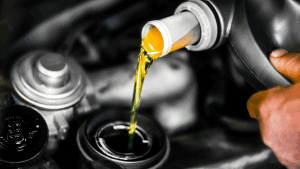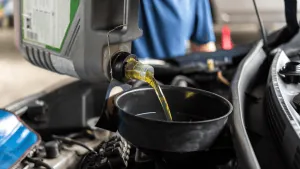Contents
- How Long to Let Engine Cool Before Adding Oil: 3 Best Recommendations
- Understanding the Importance of Letting the Engine Cool
- Recommended Duration for Letting the Engine Cool
- How long to let engine cool before checking oil
- Putting oil in car while engine is hot
- How often should you top up engine oil
- How long does it take an engine to cool down completely
- Can you top up engine oil without draining?
- Conclusion
- Frequently Asked Questions
How Long to Let Engine Cool Before Adding Oil: 3 Best Recommendations
How long to let engine cool before adding oil?
Adding oil to your engine is an essential part of regular vehicle maintenance.
However, it’s crucial to understand the importance of allowing the engine to cool before performing this task.
In this informative blog post, we will discuss the optimal duration for letting the engine cool before adding oil.
By following these best practices and recommendations, you can ensure a smooth and effective oil change process.
Understanding the Importance of Letting the Engine Cool
Heat Dissipation:
Engines operate at high temperatures, and the oil within them can reach elevated levels as well.
Allowing the engine to cool before adding oil allows the excess heat to dissipate.
This not only protects you from potential burns but also helps prevent oil foaming and ensures accurate oil level readings.
Oil Drainage:
Hot oil flows more freely, making it easier to drain during an oil change.
Allowing the engine to cool allows the oil to settle in the oil pan, ensuring a more thorough drainage process.
This helps remove old, contaminated oil more effectively, making way for fresh oil.
Recommended Duration for Letting the Engine Cool
General Guidelines:
As a general rule of thumb, it is advisable to let the engine cool for approximately 15 to 30 minutes before adding oil.
This duration allows the engine to cool down significantly while still retaining some residual warmth.
However, specific factors may influence the recommended cooling time, as outlined below.
Engine Design and Size:
Engines with larger capacities or more complex designs may retain heat for longer periods.
In such cases, it is wise to extend the cooling time accordingly.
Consult your vehicle’s owner’s manual or manufacturer guidelines for specific recommendations regarding your engine’s cooling duration.
Ambient Temperature:
Warmer ambient temperatures can prolong the cooling process, as the surrounding air may hinder heat dissipation.
If you’re performing an oil change in hot weather conditions, consider allowing a bit more time for the engine to cool adequately.
How long to let engine cool before checking oil
When it comes to checking the oil level in your engine, it is important to allow sufficient time for the engine to cool down.
The exact duration for cooling may vary depending on the engine type and the recent operating conditions.
However, as a general guideline, it is recommended to let the engine cool for approximately 10 to 15 minutes before checking the oil level.
Allowing the engine to cool before checking the oil is crucial for accurate readings.
When the engine is hot, the oil circulates throughout the system and can be significantly warmer than the ambient temperature.
This can cause the oil to expand and falsely elevate the oil level on the dipstick, potentially leading to an incorrect reading.
By giving the engine enough time to cool down, the oil will settle back into the oil pan, ensuring a more accurate measurement of the oil level.
This allows you to obtain a reliable assessment of the engine’s oil status and make appropriate decisions regarding oil maintenance, such as adding or changing the oil.
Remember, safety should always be a priority when working with a hot engine.
Take necessary precautions to avoid burns or injuries while waiting for the engine to cool.
It is advisable to consult your vehicle’s owner’s manual or manufacturer’s recommendations for specific guidance on cooling time before checking the oil level, as some engines may have unique requirements.
Putting oil in car while engine is hot
Putting oil in a car while the engine is hot is generally not recommended.
It is best to wait for the engine to cool down before adding oil.
When the engine is hot, the oil can reach high temperatures, causing it to expand and potentially overflow when adding more oil.
This can result in a messy and unsafe situation.
Additionally, handling hot engine components can pose a risk of burns or injuries.
It is important to prioritize personal safety and allow the engine to cool before attempting any maintenance tasks, including adding oil.
To ensure the most accurate oil level measurement and proper oil distribution, it is advisable to wait for the engine to cool for at least 10 to 15 minutes.
This allows the oil to settle back into the oil pan, providing a more accurate reading when checking the oil level on the dipstick.
If you find that your engine requires oil while it is still hot, it is recommended to exercise caution and follow the manufacturer’s guidelines.
Some vehicles may have specific instructions for adding oil to a hot engine.
In such cases, it is important to refer to the owner’s manual or consult a professional to ensure proper procedures are followed and potential risks are minimized.
Overall, it is always safer and more effective to wait for the engine to cool down before adding oil to your car.
This helps maintain personal safety, prevent oil overflow, and ensure accurate oil level measurements for optimal engine performance.
How often should you top up engine oil
The frequency of topping up engine oil depends on several factors, including the age and condition of the engine, driving habits, and the oil consumption rate of the vehicle.
As a general guideline, it is recommended to check the engine oil level regularly, typically once a month or before long trips.
Checking the oil level on a regular basis allows you to monitor any gradual oil loss or significant drops in the oil level.
It is essential to maintain the oil level within the recommended range to ensure proper lubrication and optimal engine performance.
If you notice that your vehicle is consuming oil more rapidly than usual, it may be necessary to top up the oil more frequently.
High-mileage engines or older vehicles tend to consume oil at a faster rate, requiring more frequent oil top-ups.
In such cases, it is advisable to monitor the oil level more closely and top up as needed to maintain the recommended oil level.
It is important to note that topping up engine oil should be done with the same type and grade of oil that is already in the engine.
Mixing different oil brands or grades can affect the oil’s performance and potentially cause issues.
Therefore, it is recommended to refer to the vehicle’s owner’s manual or consult a professional for guidance on the specific oil requirements for your engine.
Regularly checking the engine oil level and topping up as necessary is an essential part of proper vehicle maintenance.
By ensuring the engine has adequate oil at all times, you can prolong the life of the engine, prevent potential damage, and enjoy reliable performance from your vehicle.
AMSOIL Synthetic Motorcycle Oil vs. Harley Davidson Motor Oil
How long does it take an engine to cool down completely
The time it takes for an engine to cool down completely can vary depending on several factors, including the operating conditions, ambient temperature, and the size of the engine.
In general, it can take anywhere from 30 minutes to a few hours for an engine to cool down completely.
After the engine is turned off, the cooling process begins. Initially, the engine temperature will drop quickly within the first few minutes as the hot components start to dissipate heat.
However, it’s important to note that even though the surface temperature may feel cooler, the internal components of the engine may still retain heat.
For smaller engines or engines that have been running at lower temperatures, the cooling process may be relatively faster, and the engine can cool down completely within 30 to 60 minutes.
However, larger engines or engines that have been running at higher temperatures, such as after long trips or heavy towing, may require several hours to cool down completely.
It is crucial to allow the engine sufficient time to cool down before performing any maintenance tasks or opening the hood.
Attempting to work on a hot engine can be dangerous and may result in burns or injuries. It’s always recommended to prioritize personal safety and give the engine ample time to cool down completely.
Keep in mind that the specific cooling time can vary based on the vehicle make and model, as well as the conditions in which the engine was operating.
To get a more accurate estimate of the cooling time for your specific vehicle, it’s best to consult the owner’s manual or contact the manufacturer for guidance.
Can you top up engine oil without draining?
Yes, it is possible to top up engine oil without draining the existing oil.
Topping up the oil is a common practice when the engine oil level falls below the recommended range.
It is important to maintain the oil level within the appropriate range for optimal engine performance and protection.
To top up the engine oil, follow these steps:
- Park your vehicle on a level surface and ensure the engine is turned off.
- Locate the engine oil dipstick, typically identified by a brightly colored handle and labeled “Engine Oil” or “Oil Level.”
- Remove the dipstick from its tube and wipe it clean with a lint-free cloth or paper towel.
- Reinsert the dipstick back into the tube completely, making sure it is fully seated.
- Remove the dipstick again and observe the oil level. The dipstick will have markings indicating the minimum and maximum oil levels. Ensure that the oil level is below the maximum mark but above the minimum mark.
- If the oil level is low, you can add oil to bring it back to the recommended level. Carefully pour the appropriate type and grade of oil into the engine oil filler cap located on the top of the engine. Use a funnel if needed to prevent spills.
- Add small amounts of oil at a time and recheck the oil level using the dipstick. Repeat this process until the oil level reaches the desired range.
It is important not to overfill the engine with oil, as it can lead to foaming, reduced lubrication, and potential damage.
Follow the manufacturer’s recommendations regarding the type of oil and the correct oil capacity for your specific engine.
While topping up the oil without draining is common, it is important to note that regular oil changes are necessary to maintain the overall health of the engine.
Oil changes help remove contaminants and refresh the lubricating properties of the oil.
It is advisable to follow the recommended oil change intervals as specified by the vehicle manufacturer to ensure optimal engine performance and longevity.
Conclusion
Taking the necessary time to let the engine cool before adding oil is a crucial step in maintaining your vehicle’s performance and longevity.
By following the recommended guidelines and allowing sufficient cooling time, you can ensure a safer and more effective oil change process.
Remember to consult your vehicle’s owner’s manual or manufacturer guidelines for specific recommendations tailored to your engine.
Regular oil changes, performed with care and consideration, will help keep your engine running smoothly for miles to come.
Frequently Asked Questions
Q. Can you add oil to a hot engine? A. It is generally recommended to add oil to a cooled engine. However, in certain situations where immediate oil top-up is necessary and the engine is hot, precautions should be taken to ensure safety and prevent any potential mishaps. When adding oil to a hot engine, it is important to exercise caution to avoid burns or accidents. First and foremost, it is advisable to use a rag or wear protective gloves to shield your hands from the hot surfaces. This will help prevent any direct contact with the engine components that may still retain heat. Additionally, it is crucial to pour the oil slowly and carefully to avoid splashing or spillage. By taking these precautions, you can minimize the risk of burns and safely add oil to a hot engine if required. However, if possible, it is always best to wait for the engine to cool down before adding oil to ensure optimal safety and accuracy in oil measurement. Q. How long should I let my engine cool before changing the oil? A. To ensure a thorough and safe oil change process, it is recommended to let the engine cool for an adequate amount of time before proceeding with the oil change. The duration required for the engine to cool down can vary depending on several factors, including the ambient temperature, the engine's size, and the recent operating conditions. However, a general guideline is to allow the engine to cool for at least one hour before initiating the oil change. By letting the engine cool for this duration, you allow the engine components and the oil to reach a temperature closer to the ambient conditions. This helps minimize the risk of burns and ensures a safer working environment during the oil change. Moreover, a cooled engine allows the oil to settle back into the oil pan, facilitating a more effective and thorough draining process. Waiting for the engine to cool down adequately also helps ensure accurate oil level measurements. Cold oil can have a different viscosity than hot oil, which may affect the accuracy of the oil level reading. Allowing the engine to cool ensures that the oil has had sufficient time to settle, providing a more precise reading when checking the oil level. By adhering to the recommended cooling time of at least one hour, you can perform your oil change with confidence, promoting safety, accuracy, and the overall well-being of your engine. Q. How long should I let my engine cool before changing oil? A. The recommended time to let your engine cool before changing the oil can vary depending on the specific circumstances and personal preference. However, a common guideline is to allow the engine to cool for at least 30 minutes to an hour before starting the oil change process. Allowing the engine to cool ensures that the oil has settled back into the oil pan, reducing the risk of burns or injuries from handling hot engine components. Additionally, a cooler engine allows the oil to drain more effectively, improving the overall efficiency of the oil change. However, it's important to note that the engine should not be completely cold during an oil change. If the engine is too cold, the oil can become thick and may not flow out as easily. Therefore, striking a balance between cooling down the engine and ensuring it is not overly cold is important for a successful oil change. Q. Can you add oil to a hot engine? A. It is generally not recommended to add oil to a hot engine. Adding oil to a hot engine can result in potential safety hazards and inaccuracies in oil measurement. When the engine is hot, the oil can be at a significantly higher temperature than the ambient air, causing it to expand. Adding cold oil to a hot engine can lead to rapid expansion and potentially cause the oil to splatter or overflow, resulting in a messy and unsafe situation. To avoid such risks, it is best to wait for the engine to cool down before adding oil. Allow the engine to cool for approximately 10 to 15 minutes to ensure a safer and more accurate oil level measurement and oil addition process. Q. How long should you let your car sit after adding oil? A. After adding oil to your car, it is recommended to let the car sit for a few minutes to allow the oil to settle and circulate within the engine. A common guideline is to let the car sit for about 5 to 10 minutes. During this time, the oil will flow down to the oil pan, ensuring that the dipstick reading provides an accurate measurement of the oil level. Additionally, giving the oil some time to circulate allows it to reach various engine components, ensuring proper lubrication and optimal performance. However, it's important to note that the specific time can vary depending on the vehicle make and model. Some vehicles may require a longer sitting time to ensure proper oil distribution. It is advisable to consult your vehicle's owner manual for manufacturer recommendations regarding the ideal sitting time after adding oil. By allowing the car to sit for a short duration after adding oil, you can help ensure accurate oil level measurements and promote effective oil circulation for the well-being of your engine.





